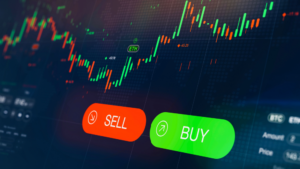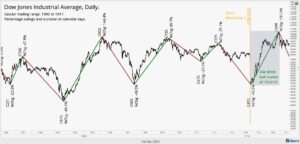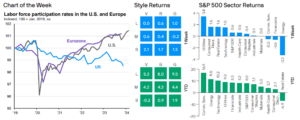By: Carl Kaufman, Bradley Kane, Craig Manchuck
Despite persistent inflation and elevated short-term interest rates, the economy appears to be holding up well, and we believe the Fed may deliver the “soft landing” it has been trying to engineer.
So, What’s New with You?
Each quarter we try to find a subject to write about that we hope gives our readers some insight into the markets in which we invest. There are times when that is harder to do than others; this is one of those times. The second quarter saw a continuation of the trends we have seen since last fall – namely, a generally healthy market for equities and high yield bonds, an economy that continues to grow, albeit at a slower pace, and the easing of inflationary pressures. The major change is that the Fed paused the rate hike in June, as the markets requested/predicted. So, where do we go from here?
Since there is a meaningful correlation between the equity and high yield markets, we feel it is important to look at both to inform us of investors’ risk tolerance. Year-to-date, the equity market, as measured by the S&P 500 Index, returned 16.9% through June 30, 2023. While that is impressive, a preponderance of that return is due to the performance of a small number of the more largely capitalized stocks in the index. They used to be called FAANG (Facebook, Apple, Amazon, Netflix, and Google) and recently Microsoft and Tesla have been added to the list. One portfolio manager here dubbed them “MT. FAANG.” In addition, some are proposing (unofficially of course) that Nvidia, which recently broached one trillion dollars in market capitalization, be added to the list.
Since the S&P Index is market cap-weighted, these mega cap stocks have a large impact due to both stellar returns and heavy weight. We know of no non-index replicating portfolio manager (read: active) that constructs a portfolio based on market capitalization. Rather, they typically size holdings based on conviction levels and generally are more or less equally weighted. Therefore, we feel a better benchmark is the S&P 500 Equal Weight Index. The performance gap between the two indices recently has been stark, echoing the late 1990s, when you were almost assured underperformance if you did not own the handful of market-leading stocks. For the three years from 1997-1999, the S&P 500 returned a whopping 107.6% un-annualized while the S&P Equal Weight returned a more modest 62.2% – still impressive but about half the cap-weighted version. While the divergence year-to-date is large, looking back three years, the equal weighted index has in fact slightly outperformed.
Many market observers today fear that there may be market risk if the MT. FAANG stocks underperform meaningfully at some point, especially if there is a recession looming on the horizon. While history does not always repeat, we can look to the past for some insight. In the years 2000-2003, which saw us through the dot com bust and a 9/11-induced recession, the S&P 500 lost 19.7% versus the Equal Weight Index’s gain of 26.0%. This could be indicative of what may happen in the future if there is a recession.
The Fed paused its tightening cycle in June and the debate now revolves around whether it is a longer pause or simply a skip, followed by more increases. As they said in their press conference, the CPI and other economic data will determine future actions. Given the long-lasting yield curve inversion (short rates higher than long rates), many investors seem to think a long pause is more likely. Jim Bianco points out that it may not be so straightforward. He observes that June of last year was the peak monthly increase in CPI at 1.2% and that the number drops off for the year-on-year CPI gauge for the period ending June 2023, meaning that we will be comparing against declining inflation reports. This will mean that it is possible that we see rising CPI inflation in the second half of 2023. It would be very unlikely, therefore, to approach the Fed’s 2% target this year. He showed three scenarios to estimate what year-end 2023 CPI could be. We thank the Cleveland Fed’s NowCast for these calculations. First, assuming 0% inflation through year-end, unlikely as that is, year-over-year CPI would end the year at 2.87%. Second, assuming we return to the average monthly inflation seen from 2009 to 2019 of 0.15%, CPI would end the year at 3.79%. Lastly, assuming the average post-Covid monthly inflation of 0.42%, we would get a year-end reading of 5.47%. Barring any exogenous shocks to the system, the truth is likely somewhere between the second and third scenarios, but in either case, CPI is still well above the Fed’s 2% target. Interestingly, the fed funds futures markets place the likelihood of Fed hikes in the July and September meetings at 84% and 29% respectively. We will be watching closely.
The other factor that the Fed keeps an eye on is employment. We have commented regularly about this metric in the past and we do not have any novel thoughts at the moment. Fortunately, the jobs numbers have held up better than the Cassandras have feared. Non-farm payrolls continue to climb, and the unemployment rate (March release) was at a cycle low of 3.5%. While job openings are down from their peak in March 2022, they have climbed for the past three months. Additionally, the Labor Force Participation Rate has been steadily climbing, and for the past three months has matched the March 2020 high of 62.6%, although it is still below pre-pandemic levels. Yearly gains in average hourly earnings, while growing a bit slower than in early 2022, rose a healthy 4.3% in May. All in all, these point to a relatively healthy labor market.
Speaking of the consumer, John Silvia from Dynamic Economic Strategy (DES) observes that an important way to measure consumer health is to look at their financials. Specifically, he looks at the financial obligation ratio published by the Fed. This includes rent, auto leases, homeowners’ insurance, and property taxes, so it is a broader measure than the debt service ratio . He points out there was a “statistically significant break in the series after … 2007-2009. On average, households became more cautious about their indebtedness.” The first quarter ratio was 14.3%, compared with the pre-Covid reading of 14.7% in Q4 2019, and well below the 17-18% seen leading up to the Great Financial Crisis of 2008. He further notes that “Recent improvements for real disposable income and consumer sentiment … will support continued consumer spending and economic growth. Real disposable income is up 2.8% over a year ago. Consumer Sentiment is at 64.6–above a year ago levels. These fundamentals support the case for continued consumer spending.” Additionally, delinquency rates for credit cards remain below pre-Covid levels but have risen recently. In sum, the consumer has the wherewithal to support economic growth, even if it does slow.
For investors, this presents a relatively calm sea, but as always, worries remain about what undercurrents may rise up and flip the boat. The truth is that we cannot structure portfolios to account for all possible eventualities and still find a healthy balance between risk and reward. So far markets seem to be muddling past matters such as climate change and geopolitical issues. Our view is optimistic that barring an unforeseen event, the U.S. economy will avoid a so-called “hard landing” and likely experience slower growth that will be accompanied by higher inflation and interest rates than became the norm during the post-2008 era. We continue to maintain healthy levels of defensive, short-term assets, for which (thanks to the inverted yield curve) we are being well compensated. There will be periods of uncertainty where we can add longer-dated bonds with higher yields, and we are patiently waiting for those opportunities.
We are always available should you have questions.
—
Originally Posted July 18, 2023 – Third Quarter Strategic Income Outlook
Disclosure: Interactive Brokers
Information posted on IBKR Campus that is provided by third-parties does NOT constitute a recommendation that you should contract for the services of that third party. Third-party participants who contribute to IBKR Campus are independent of Interactive Brokers and Interactive Brokers does not make any representations or warranties concerning the services offered, their past or future performance, or the accuracy of the information provided by the third party. Past performance is no guarantee of future results.
This material is from Osterweis Capital Management and is being posted with its permission. The views expressed in this material are solely those of the author and/or Osterweis Capital Management and Interactive Brokers is not endorsing or recommending any investment or trading discussed in the material. This material is not and should not be construed as an offer to buy or sell any security. It should not be construed as research or investment advice or a recommendation to buy, sell or hold any security or commodity. This material does not and is not intended to take into account the particular financial conditions, investment objectives or requirements of individual customers. Before acting on this material, you should consider whether it is suitable for your particular circumstances and, as necessary, seek professional advice.






























Join The Conversation
If you have a general question, it may already be covered in our FAQs. If you have an account-specific question or concern, please reach out to Client Services.